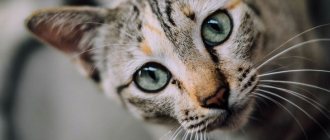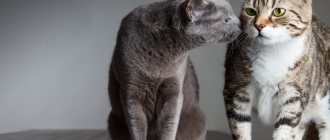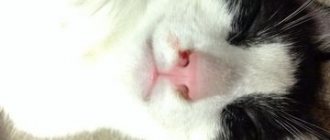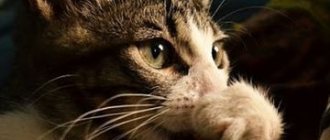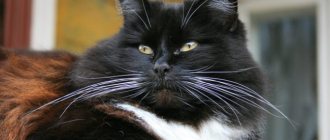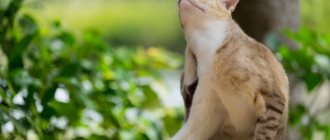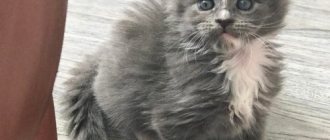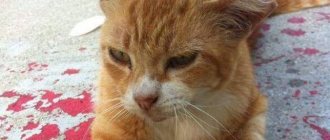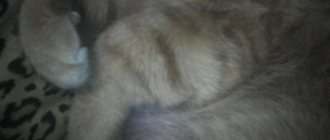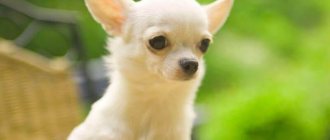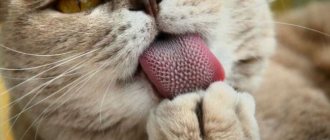Physiological change of teeth
Kittens are born toothless. Their primary incisors erupt at the age of 1-2 weeks. A two-month-old baby should already have at least 26 teeth. But they begin to fall out at 3-4 months. The change process also lasts 3-4 months, ending at 7 months.
Monitor your baby's health, count how many and which teeth have fallen out. An adult cat should have 30 of them: 6 incisors, 2 canines, 2 molars on the lower and upper jaws. There are 10 premolars: 6 on the lower jaw and 4 on the upper jaw.
When changing baby teeth, a cat may experience symptoms such as:
- hypersalivation;
- chewing inedible objects;
- decreased activity;
- irritability, excitability.
Often the process of changing teeth occurs with complications - instead of 4 fangs, 8 grow. This is due to the fact that the formation of molars occurs in separate follicles: the milk ones have not yet fallen out, but new ones are already actively growing. The kitten experiences discomfort, cannot chew and therefore loses weight.
In such cases, you need to go to the clinic to have a specialist remove the loose tooth. The procedure is performed under anesthesia.
Change of teeth, which takes place without complications, does not require medical intervention. The main thing is that the dishes in the baby’s diet contain the required amount of mineral salts, calcium and phosphorus.
Have you changed?
So, we know why a cat loses teeth before the age of one year. But how can you tell if your teeth have changed? Temporary teeth are very easy to distinguish from permanent teeth. They will be much sharper, with a curved shape. At the point of contact with the gum they are very thin. If you see not four, but eight teeth, then you shouldn’t worry at first. You should watch the animal. If the teeth do not change on their own, the kitten will have to be helped. This should be done by a specialist. You cannot remove an old tooth at home. In addition, an experienced and qualified doctor can determine the pathology and can explain why the cat’s teeth fall out at 2 or 3 years old. The veterinarian will also help correct the kitten’s malocclusion.
Causes of tooth loss in adult cats
It is easy to distinguish baby teeth from permanent ones: the first ones are white, sharp, like needles. They are slightly flat, and there is a slight thinning where the tooth meets the gum. The fangs are curved back. Indigenous (permanent) have a yellowish tint, with a more rounded cross-section. The canines are straight, there is no thinning in the gum area.
If a cat is kept in good conditions, receives a balanced diet enriched with nutrients, vitamins and microelements, and is not exposed to external traumatic factors, it may well retain its teeth into old age.
However, if a pet loses them after it is 1 year old, that is, we are talking about the loss of permanent teeth, this is an alarming signal, indicating the presence of serious pathologies occurring in the body.
It is important to understand: adult cats’ teeth do not simply fall out. This is a problem not only of the oral cavity, but also of the whole body, since the mucous membrane of the mouth and gums have many blood vessels through which the infection spreads throughout the body.
By the age of three, a cat’s dental plaque turns into stone, so the oral cavity needs careful care - cleansing with special pastes. If hygiene procedures are neglected, tooth loss cannot be avoided in the future.
Tooth loss in an adult animal may indicate the following problems in the body:
- injuries in the mouth;
- weakening of the immune system;
- disruption of the natural microflora in the oral cavity, colonization of it by pathogenic bacteria;
- vitamin deficiency;
- diabetes mellitus;
- tartar;
- metabolic disorders;
- changes in hormonal levels (pregnancy, taking hormonal medications, including contraceptives, antibiotic therapy, etc.);
- dental diseases (gingivitis, periodontal disease, caries, etc.);
- malocclusion;
- gastrointestinal pathologies;
- oncology.
The idea that all cats lose their incisors in old age is wrong. If the animal is healthy, the onset of old age is not an argument for poor dental health. The exception is the age of 20 years and older, but a rare cat survives to that age.
The loss of the chewing apparatus of its structural units is associated with diseases, poor care and unbalanced nutrition, but not with age.
Over the years, various changes in the condition and shape of teeth do occur. It has been proven that the approximate age of a cat can be determined by the number of worn teeth - the more teeth there are, the older the animal.
The first to wear off are the incisors on the lower jaw (towards the edges from the center), their shape becomes transversely oval. Then comes the turn of the molars and premolars. The last ones to lose enamel are the fangs.
Main symptoms
The clinical picture of tooth loss varies depending on the cause that caused this phenomenon. If a structural unit of the mastication apparatus falls out due to injury, it is enough to treat the wound with a disinfectant solution, and if it does not become infected, the damaged area will heal safely.
The following symptoms are reasons to contact a veterinary clinic:
- gums become swollen, red, and bleed;
- saliva is released abundantly, which is why the cat’s face and neck are constantly wet;
- ulcers form in the oral cavity;
- pus in saliva;
- a foul smell of rotting emanates from the mouth;
- presence of difficulties with chewing;
- lack of appetite.
As a rule, the cat’s behavior changes, he becomes restless, apathetic, and loses weight. The animal refuses food, even if it is very hungry. If a cat tries to eat, he does it very carefully and slowly, as chewing causes him discomfort. As a rule, he also refuses water.
The owner should observe the condition of the animal; it is advisable to write down changes in order to tell the veterinarian about them. This will greatly facilitate diagnosis and determine treatment.
Diet for a kitten
During the period of bone tissue formation, food should contain a sufficient amount of calcium and fluorine. A lack of mineral elements will cause delayed, uneven tooth replacement. Dry food for kittens contains all the necessary mineral supplements and will be useful as crackers for massaging swollen gums. The kitten may refuse to eat because they are sore, but this may not last long. A cat, as a predator by nature, cannot starve for more than 2 days. A small cat will only be able to skip one feeding. If he continues to starve, then you need to contact your veterinarian.
© shutterstock
Treatment method and prognosis
There is no single treatment regimen. Therapy is compiled individually in each specific case and depends on the age of the cat, its state of health and the cause of tooth loss. A lost tooth cannot be restored; the veterinarian’s task is to prevent subsequent losses.
To solve the problem, the specialist makes adjustments to the cat’s diet and prescribes medications to strengthen the teeth and immune system.
Regarding vitamin therapy, we can say that there is no need to give vitamin C in loading doses. In cats, ascorbic acid is synthesized in sufficient quantities, so they do not develop scurvy.
If the animal has tartar, it is removed in the clinic. The procedure is performed under anesthesia, for which premedication is used - the administration of anticholinergic drugs to block vagal reflexes. These drugs cause the least harm to the animal’s body. During the operation, the cat will be conscious, but will not be able to resist.
After recovering from anesthesia, your pet will need quality care, as the procedure is stressful for him.
In parallel with this, treatment is carried out aimed at strengthening the gums and reducing their bleeding. But the main emphasis is on eliminating the underlying disease that caused tooth loss.
Prevention measures
If you pay attention to your cat’s health and provide quality care for it, then problems such as tooth loss can be avoided. Regular brushing of teeth is the prevention of tartar, which, most often, is a provoking factor. Cats living outside clean their mouths on their own by chewing twigs and grass.
Pets are deprived of this opportunity, so the owner must regularly carry out hygiene procedures - brushing their teeth. If you accustom a cat to them from an early age, he will not resist the process, perceiving manipulation as a natural process.
To clean teeth, special pastes are used, which can be purchased at a veterinary pharmacy. Such pastes do not need to be washed off with water.
Human pastes cannot be used, as a high concentration of some components in the composition will negatively affect the health of the pet. In addition, the smell of menthol contained in most toothpastes irritates animals.
You can brush your teeth with a special brush, but a regular brush for small children with soft bristles will also work. To prevent tartar, use toys and medicated dry food, which should be given from time to time.
Particular attention should be paid to feeding the pet. If preference is given to natural food, the diet includes meat, fish, vegetables, and dairy products. Food from your own table is prohibited. If you use dry food, it is advisable to choose premium and super premium products that contain sufficient amounts of vitamins and minerals.
It is imperative to take your pet to a veterinary clinic so that diseases can be identified at an early stage, vaccinated in a timely manner, and treated for parasites. To avoid injury to the jaws and head area, you should not leave your four-legged pet alone. Windows and vents must be closed in your absence!
Sources:
https://www.belanta.vet/vet-blog/vypadayut-zuby-u-koshek/
https://koshkamurka.ru/5429-pochemu-u-koshek-vypadayut-zuby.html#i-3
https://oozoo.ru/koshki/pochemu-u-kotov-vypadayut-klyki.html
What to do at home
The owner is required to strictly follow the veterinarian's instructions. Self-medication is dangerous for the cat’s health and can cause irreparable harm to it. Medicines and their dosage are determined by a specialist.
In order for the animal to lead a normal lifestyle, it is necessary to change the consistency of the food, since dry granules can further injure the oral cavity.
The oral cavity is regularly examined and treated with a disinfectant solution of Chlorhexidine. These procedures prevent infection of the enamel and damage to other teeth.
